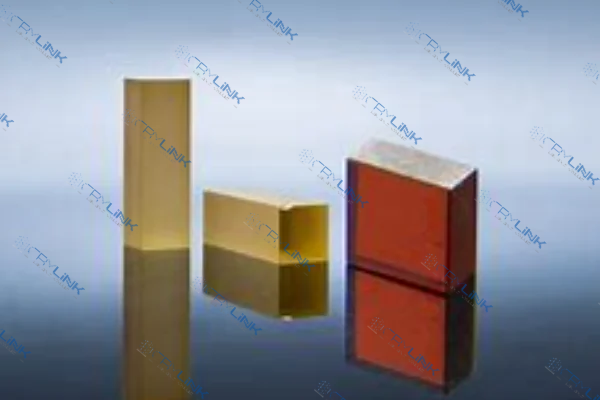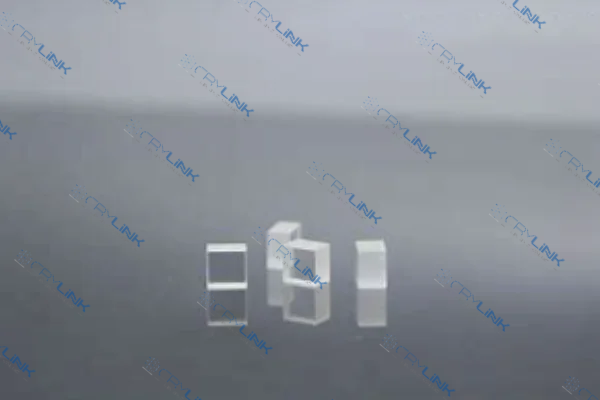Introduction: The Crystal Conundrum in Mid-infrared Lasers
In the domain of laser technology, the choice of crystal material can have profound implications on performance, application versatility, and efficiency. Two such materials that have emerged as key contenders in the mid-infrared laser realm are Cr:ZnSe and Cr:ZnS crystals. This article offers a deep dive into these two crystals, comparing their distinctive attributes and evaluating their applicability in various domains.

Basic Properties: Delving Deeper into the Fundamentals
Crystals have always been at the forefront of technological innovations, especially in the realm of laser technology. The inherent properties of crystals determine their efficiency, tunability, and overall performance in various applications. Among the plethora of crystals available, Cr:ZnSe and Cr:ZnS have emerged as two of the most promising contenders. Let’s delve deeper into the intrinsic properties of these two crystals.
Cr:ZnSe crystals, with their unique structural composition, stand out in the world of laser technology. The integration of Chromium (Cr) ions into the Zinc Selenide (ZnSe) matrices has led to the creation of a crystal with remarkable attributes. Its ability to showcase a wide tunability range is commendable, allowing for adaptability across different applications. Furthermore, its high damage thresholds ensure durability, making it a sought-after choice for applications that demand resilience.
The structural foundation of Cr:ZnSe is built upon the harmony between Chromium and Zinc Selenide. This intricate balance results in a crystal that not only excels in performance but also promises longevity, making it a valuable asset in the ever-evolving world of laser technology.
On the other side of the spectrum lies the Cr:ZnS crystal, another marvel in the world of laser crystals. The process of embedding Chromium ions into Zinc Sulfide matrices gives rise to a crystal with a distinct profile. Unlike its counterpart, Cr:ZnS is renowned for its thermal conductivity. This property ensures that the crystal remains stable and efficient, even in environments where temperature regulation is pivotal.
Moreover, the stability offered by Cr:ZnS crystals ensures that they remain unaffected by external factors, making them an ideal choice for applications where consistency and reliability are paramount. The union of Chromium and Zinc Sulfide results in a crystal that is not only robust but also versatile, catering to a wide range of applications with ease.
In conclusion, while both Cr:ZnSe and Cr:ZnS crystals have their unique strengths, their foundational properties make them indispensable in the world of mid-infrared lasers. Whether it’s the tunability of Cr:ZnSe or the stability of Cr:ZnS, both crystals have carved a niche for themselves, promising a future of endless possibilities.

Tunability: The Wavelength Adaptability
Tunability, in the world of laser technology, is akin to a chameleon’s adaptability in nature. Just as a chameleon adjusts its colors to blend seamlessly into its environment, tunable lasers can modify their wavelengths to suit specific applications. The heart of this adaptability lies in the crystals used, and Cr:ZnSe and Cr:ZnS stand out prominently in this regard.
Cr:ZnSe crystals, with their exceptional tunability range, have carved a niche for themselves in diverse sectors. The flexibility they offer in wavelength adaptation is nothing short of remarkable. For instance, in medical procedures where precision and safety are paramount, Cr:ZnSe’s ability to adjust to the exact required wavelength ensures that only the targeted cells or tissues are affected, leaving the surrounding areas unharmed. Similarly, in the realm of advanced spectroscopy, the ability to tune into specific wavelengths enables researchers to obtain detailed and accurate data, paving the way for groundbreaking discoveries.
On the other hand, Cr:ZnS crystals are not far behind. While they share the broad tuning range characteristic with Cr:ZnSe, their adaptability comes with a touch of precision that’s unparalleled. In applications where even a minor deviation from the required wavelength can lead to significant discrepancies, Cr:ZnS shines brightly. Their innate ability to fine-tune to exact wavelengths ensures precision, making them the go-to choice for applications where there’s no room for error.
However, it’s not just about the range but also the speed of tunability. Both these crystals can swiftly shift across wavelengths, ensuring they meet the dynamic demands of real-time applications. Whether it’s adjusting to the rapid changes in a medical procedure or adapting to the fluctuating requirements of a research experiment, these crystals rise to the occasion, showcasing their true potential.
In essence, the world of mid-infrared lasers is witnessing a revolution, and at the heart of this transformation are the Cr:ZnSe and Cr:ZnS crystals. With their unparalleled tunability and adaptability, they promise to redefine the boundaries of what’s possible, heralding a new era in laser technology.

Thermal Conductivity: Efficiency in Heat Management
Thermal conductivity, often an overlooked aspect in many technological applications, plays a pivotal role in the efficiency and longevity of laser systems. In the microscopic world of crystals, the ability to manage heat can be the difference between optimal performance and potential breakdown.
Cr:ZnSe crystals, with their unique composition, have showcased a level of thermal conductivity that is indeed laudable. Their ability to conduct heat, albeit with certain limitations, means they can sustain operations without succumbing to heat-induced degradation rapidly. However, this commendable trait also comes with its set of challenges. As laser systems are scaled up, especially in high-power applications, the demand for efficient heat management becomes more pressing. In such scenarios, the slightly limited thermal conductivity of Cr:ZnSe can pose hurdles. It’s akin to a sports car engine that performs exceptionally well under standard conditions but may experience challenges when pushed to its limits on a racetrack.
Enter Cr:ZnS crystals, the stalwarts of thermal management in the crystal kingdom. These crystals, with their superior thermal conductivity attributes, stand as a testament to what’s achievable when nature and science converge. Their ability to dissipate heat efficiently ensures that they remain stable and functional even during extended operational hours. This characteristic is particularly beneficial in applications where the laser systems are expected to run continuously, without frequent breaks. It’s much like having a cooling system that works tirelessly to ensure the machinery doesn’t overheat, thereby ensuring consistent performance.
Beyond just the individual attributes of these crystals, it’s essential to appreciate the broader implications of thermal conductivity. Efficient heat management not only ensures optimal performance but also extends the life of the equipment, reduces maintenance needs, and, most importantly, ensures safety. A laser system that can manage its heat effectively is less prone to malfunctions, ensuring that the surrounding environment and the operators remain safe.
In the grand tapestry of laser technology, while tunability and other factors play their roles, thermal conductivity stands as the silent guardian, ensuring that systems run smoothly, efficiently, and safely. With the likes of Cr:ZnSe and Cr:ZnS in the fray, the future of mid-infrared lasers looks promising, balanced, and bright.

Application Versatility: From Medicine to Military
In the ever-evolving landscape of technology, versatility is the key to relevance. Crystals, especially Cr:ZnSe and Cr:ZnS, have showcased an impressive ability to bridge diverse domains, from the intricate world of medicine to the high-stakes arena of military and defense, and the meticulous realm of research and spectroscopy.
In the medical world, where the margin for error is minimal, the precision offered by these crystals is a game-changer. Medical procedures, especially those that involve lasers, require a level of accuracy that leaves no room for deviations. For instance, in surgeries where lasers are employed to target specific cells or tissues, the tunability of these crystals ensures that only the intended area is affected, safeguarding surrounding tissues. This precision reduces recovery times, minimizes risks, and enhances the overall effectiveness of the treatment.
Shifting gears to the military and defense sector, the demands are entirely different. Here, reliability takes precedence. Equipment needs to function optimally, irrespective of the external conditions, be it the freezing temperatures of high-altitude terrains or the scorching heat of desert warfare. Cr:ZnSe and Cr:ZnS crystals, with their robust nature, ensure that laser equipment in the defense sector remains reliable. Their ability to withstand challenging conditions without compromising performance makes them an invaluable asset on the battlefield.
When we transition to the domain of spectroscopy and research, the demands pivot towards clarity and precision. The world of research thrives on data, and the quality of this data can influence the trajectory of scientific discoveries. In applications like spectroscopy, where detailed analysis is paramount, the unique properties of these crystals come to the fore. Their ability to offer clear, precise, and consistent results ensures that researchers and scientists have the tools they need to push the boundaries of knowledge.
In conclusion, the versatility of Cr:ZnSe and Cr:ZnS crystals is not just about their adaptability across domains but also about their ability to meet the unique demands of each sector. By ensuring precision in medicine, reliability in defense, and clarity in research, these crystals are shaping the future across multiple fronts.

Conclusion: The Road Ahead for Cr:ZnSe and Cr:ZnS Crystals
Cr:ZnSe and Cr:ZnS crystals, with their unique sets of properties, have paved the way for advancements in mid-infrared laser technology. While each has its own set of advantages, the choice between them often boils down to specific application requirements. As research continues and technology evolves, one can expect further refinements in these crystals, enhancing their capabilities and widening their application horizons.
FAQs
- Q1: What are the primary benefits of Cr:ZnSe crystals?
- A1: Cr:ZnSe crystals are known for their impressive tunability range and relatively high damage thresholds.
- Q2: How do Cr:ZnS crystals fare in terms of thermal conductivity?
- A2: Cr:ZnS crystals exhibit superior thermal conductivity, making them ideal for applications that require efficient heat dissipation.
- Q3: Are these crystals suitable for medical procedures?
- A3: Yes, their precision and tunability make them ideal for various medical applications, especially targeted laser interventions.
- Q4: How do these crystals benefit the defense sector?
- A4: Their reliability and efficiency make them invaluable for military operations, especially in challenging conditions.
- Q5: Can Cr:ZnSe and Cr:ZnS crystals be used in research and spectroscopy?
- A5: Absolutely. Their clarity and precision are vital for detailed analysis in research and spectroscopy applications.

Frank
Frank graduated from the University of Shanghai for Science and Technology, majoring in optics. As a technical engineer at Crylink Company, he deeply understands crystal materials and laser components.
Related Video(s) with this Article
Related Product(s) with this Article
Related Application(s) with this Article
